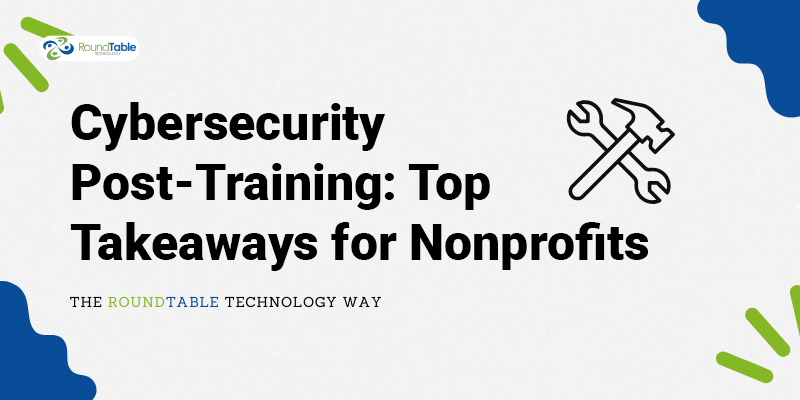3 Dangers of BYOD Use for Nonprofits
When it comes to cybersecurity, there are a lot of dangers that organizations need to be aware of. For nonprofits, bring-your-own-device (BYOD) can...
3 min read
.jpg) Justin Brown
:
Aug 2, 2024 9:58:42 AM
Justin Brown
:
Aug 2, 2024 9:58:42 AM

In 2023, a well-known nonprofit organization dedicated to providing clean water to underserved communities fell victim to a cyberattack. This attack resulted in a significant data breach, exposing sensitive donor information and severely disrupting their operations. This incident highlights a growing concern for many nonprofits: the importance of understanding and implementing cybersecurity basics. Nonprofit organizations, often perceived as easy targets due to limited resources, have a need to prioritize cybersecurity to protect their missions and the communities they serve.
Nonprofits face a variety of cyber threats, including phishing, ransomware, and data breaches. Phishing attacks often involve fraudulent emails designed to trick employees into revealing personal information or downloading malicious software. Ransomware, on the other hand, involves encrypting the organization's data and demanding payment for its release. Data breaches can result in the unauthorized access and theft of sensitive information, such as donor details and financial records.
Cybercriminals often target nonprofits because they collect and store valuable data, including donor information, financial records, and personal details of beneficiaries. Additionally, nonprofits may be perceived as having weaker cybersecurity measures compared to for-profit organizations. Limited budgets, lack of cybersecurity expertise, and the primary focus on their mission rather than IT infrastructure make nonprofits attractive targets for cyberattacks.
The consequences of cyberattacks on nonprofits can be devastating. Financial loss from ransomware payments, legal fees, and the cost of remediation can strain already limited resources. Reputational damage can erode donor trust and result in decreased donations. Operational disruption can hinder the nonprofit's ability to deliver services, affecting the communities they serve. In severe cases, the nonprofit's very existence can be threatened.
One of the simplest yet most effective cybersecurity measures is the use of strong, unique passwords. Encourage staff and volunteers to create complex passwords that combine letters, numbers, and special characters. Implement multi-factor authentication (MFA) to add an extra layer of security. MFA requires users to verify their identity through a secondary method, such as a text message or authentication app, reducing the risk of unauthorized access.
Keeping software and systems up-to-date is crucial in protecting against vulnerabilities. Cybercriminals often exploit outdated software to gain access to networks and data. Nonprofits should establish a routine schedule for software updates and patches to ensure all systems are secure. This includes operating systems, applications, and any third-party software used by the organization.
Data encryption is a vital cybersecurity practice that protects sensitive information both in transit and at rest. By encrypting data, nonprofits can ensure that even if data is intercepted or accessed without authorization, it remains unreadable and secure. Implement encryption protocols for email communications, data storage, and any online transactions involving sensitive information.
Regularly backing up data and having a robust recovery plan in place is essential for minimizing the impact of cyber incidents. Backups should be performed frequently and stored securely, preferably offsite or in the cloud. In the event of a cyberattack, a well-documented recovery plan can help restore data and resume operations quickly, reducing downtime and financial loss.
Implementing comprehensive network security measures can protect against unauthorized access and cyber threats. This includes using firewalls to monitor and control incoming and outgoing network traffic, installing antivirus software to detect and remove malware, and configuring networks securely to prevent unauthorized access. Regular network assessments can identify and address potential vulnerabilities.
Educating staff and volunteers about cybersecurity best practices is crucial in creating a security-conscious culture. Conduct regular training sessions to raise awareness about common cyber threats, such as phishing and social engineering attacks. Provide guidelines on how to recognize suspicious activities and respond appropriately. Empowering employees with knowledge can significantly reduce the risk of human error leading to cyber incidents.
Developing clear cybersecurity policies and procedures provides a framework for handling sensitive information and responding to cyber incidents. These policies should outline acceptable use of technology, data protection measures, and incident response protocols. Ensure that all staff and volunteers are familiar with these policies and understand their roles in maintaining cybersecurity.
Leadership plays a crucial role in prioritizing cybersecurity within the organization. Encourage leadership to lead by example and emphasize the importance of cybersecurity in achieving the nonprofit's mission. Hold everyone accountable for following best practices and policies. Appoint a cybersecurity champion or team responsible for overseeing and implementing cybersecurity initiatives.
Nonprofits can leverage external support and partnerships to enhance their cybersecurity posture. Managed IT services and cybersecurity consultants can provide expertise and resources that may not be available in-house. Partnering with other organizations and participating in cybersecurity networks can offer valuable insights and collaboration opportunities.
Many free and low-cost cybersecurity tools and resources are available to nonprofits. These include antivirus software, encryption tools, and online training modules. Organizations such as TechSoup offer discounted technology products and services specifically for nonprofits. Taking advantage of these resources can help strengthen cybersecurity without straining budgets.
Cybersecurity is an ever-evolving field, with new threats and vulnerabilities emerging regularly. Nonprofits should stay informed about the latest cybersecurity news and trends by subscribing to industry newsletters, attending webinars, and participating in cybersecurity forums. Staying up-to-date ensures that the organization is prepared to address new challenges effectively.
In an increasingly digital world, understanding and implementing cybersecurity basics is essential for the safety and success of nonprofit organizations. By recognizing common cyber threats, adopting key cybersecurity practices, building a culture of security, and leveraging available resources, nonprofits can safeguard their missions and the communities they serve. Now is the time for nonprofits to assess their current cybersecurity practices and take proactive steps to enhance their security posture. Ensuring robust cybersecurity is not just about protecting data—it's about protecting the future of the organization and the impact it strives to make.

When it comes to cybersecurity, there are a lot of dangers that organizations need to be aware of. For nonprofits, bring-your-own-device (BYOD) can...

In an era where cyber threats loom large over organizations of every size and sector, nonprofits in Texas are finding themselves increasingly in the...

In our increasingly digital world, cybersecurity is not just a buzzword but a critical foundation of any organization's operational integrity. This...